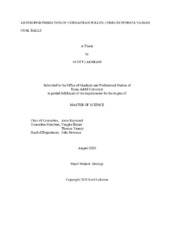| dc.description.abstract | Pennsylvanian coal balls are concretions of permineralized peat that contain a rich fossil record of plant-animal interactions. Cordaitean leaf-mat coal balls from the Cliffland and Blackoak coal beds (Kalo Formation, Iowa) commonly contain cordaitean pollen cones with fecal pellets (20 – 200 μm in their widest minimum dimension) filled with macerated pollen (golden in color), or vegetative debris (dark in color). The size of fecal pellets suggests production by ancient collembolans, oribatid mites, or an extinct microarthropod group. Cordaitean leaf-mat peat also contains pollen-filled coprolites (200–1000 μm in their widest minimum dimension) that are consistent in size with production by insects. Maceration of pollen in fecal pellets and coprolites suggests the producers derived nutrition from pollen consumption, however, pollen-filled fecal pellets and coprolites could result from palynivory or detritivory. We analyzed the distribution of pollen and vegetation-filled fecal pellets and coprolites in two data sets from the Kalo Formation: 192 cordaitean secondary fertile shoots from 84 mounted slides on loan from the Harvard Paleobotanical Herbarium; 111 cordaitean secondary fertile shoots from 26 peels made from 22 coal balls containing cordaitean leaf-mats. In both data sets, pollen-filled fecal pellets occurred in 15 - 20% of all cordaitean cones, and 44 – 53% of mature cones. Only 9 - 14% of all pollen-filled fecal pellets occurred outside of cordaitean secondary fertile shoots, in the peat matrix. In leaf-mat peels, isolated pollen-filled fecal pellets and cordaitean cones with pollen-filled fecal pellets occurred in the same peat layers suggesting that fecal pellets were produced by palynivores in the canopy and shaken out of cones as they fell to the peat surface. Most cordaitean pollen aggregates in cordaitean leaf-mat peat occurred in the form of pollen-filled coprolites. Pollen cones with undispersed pollen rarely occurred. In both data sets; only 14/303 (5%) of cones had large accumulations of pollen. The scarcity of undispersed cordaitean pollen in cordaitean leaf-mat peat suggests pollen-filled coprolites resulted from palynivory by flying insects in the canopy. The presence of pollen-filled fecal pellets and coprolites in cordaitean cones and leaf-mat peat is among the earliest evidence of probable palynivory. | en |



